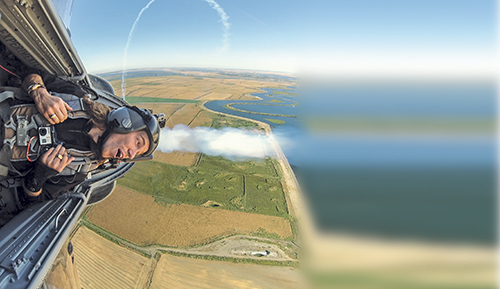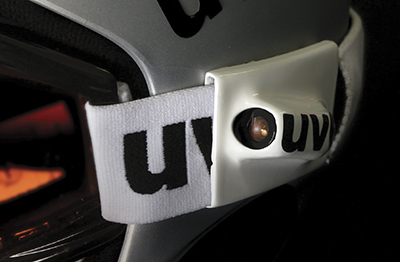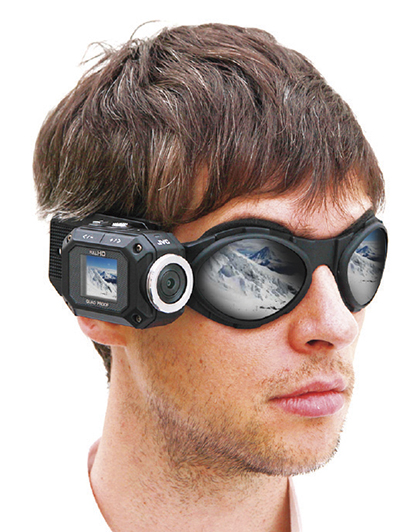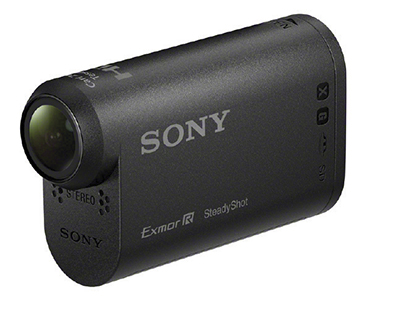Up Close and Extreme

BALTIMORE—A skier soars from a mountaintop, taking viewers along for the rush. Motocross fans get a ground-level view of the bound tension at the starting line. An IndyCar speeds around a curve, with the driver’s breathtaking viewpoint suddenly on-screen.
Such dramatics are made possible by the evolution of the point-of-view camera, which has allowed broadcasters to further accentuate productions in recent years, as refined technologies have facilitated the presentation of new angles of events to viewers.
Some POVs are made with the consumer, as well as the professional user, in mind; some are for sale, others for rent on a professional basis. As a trend, they’re heightening the viewing experience across the sports landscape.
SIMPLICITY OF USE
The attraction of the Adixxion, JVC’s new POV entry, is “the simplicity of a traditional camcorder with the durability of a POV camera,” said Karl Bearnarth, senior vice president for marketing.

Riedel’s RiCam was the technology of choice for the FIS Skiing World Cup. The other cameras on the market “have the start and stop buttons, etc.,” Bearnarth said, “but not an LCD screen set up for those functions. This makes setting the menu and framing the shot easy, because you can see what you are shooting in the screen; most other products don’t have that capability.”
That it’s freeze proof and available with a special marine housing for depths of more than 16 feet just accentuates its value; in short, the Adixxion offers the convenience of a traditional camcorder. “It’s easy to use out of the box and is packaged with few accessories, though it does come with the somewhat ubiquitous 1/4-20 connector, which can be affixed to whatever the camera is used on [like a car], with a suction cup adaptor.”
The professional video industry's #1 source for news, trends and product and tech information. Sign up below.
To trumpet the Adixxion’s specific uses, JVC has created content for its web site that it will post in late spring of a back country skier in Alaska who is dropped out of a helicopter, equipped with the cameras on his helmet, on a ski and on a ski pole mount; from a team of sky divers; and on World War II fighter planes, and general extreme sports.
EXPERIENCE COUNTS

JVC’s new Adixxion POV camera weighs barely a quarter pound, is waterproof to a depth of five meters (16.4 feet), shockproof to withstand a fall from two meters (6.5 feet), dustproof and freezeproof, all without the need for a separate housing. POV cameras are designed for such purposes, said Greg Herd, product manager for Sony, manufacturer of the HDR-AS10 and HDR-AS15. “The technology has reached the point where we are able to offer a tremendous amount of camera and image processing [in] a package of about three ounces that fits in the palm of one’s hand.”
Herd pointed to the HDRs’ image stabilization as an example of that progress. “It’s been refined over many years,” he said. “Users are getting Sony’s very best sensor, the 16-megapixel Exmor R, which facilitates improved low-light capability.” Sony also partners with Zeiss in all of its HDR cameras for lenses “for a level of sharpness of image that would be unavailable otherwise.”
Sony is also increasing the number of mounts that are available for both cameras, including those for surfboards, wrist mounts and even dogs, among others. “That’s possible because the cameras have a really narrow profile,” he said. “It’s easy to ‘set it and forget it,’ on goggles or a headband,” just as Herd said he’d done while skiing recently.
While he said Sony is “just getting started,” that’s not entirely true. “We bring technology to the table,” he said, “that a newer company can’t.”
IT’S ABOUT COVERAGE
And then there’s GoPro, a San Mateo, Calif.-based company that has come to dominate the POV camera market recently. Its top-of-the- line HERO 3 Black Edition, released last November, is smaller than a matchbox and costs $400.
It comes with various mounts, like a chest harness, according to Rick Loughery, GoPro’s director of communications, and will shoot 1080p at 60 fps, as well as 2.7K at 30 fps. “Those are the key video qualities that are often used for the X Games for course previews, as well as televised coverage of motocross.”
There are other events, like off-road truck racing and the IndyCar series, that also employ the technology, which is also Wi-fi enabled, and allow the user to remotely control the camera—from the pits of an auto race, for instance.
“Of the POV cameras on the market, it’s the smallest and lightest, thus the most versatile,” said Loughery, “and it’s used by more professional productions and pro athletes than any camera in its class.”
Wuppertal, Germany-based Riedel is in the mix with its RiCam Goggles Camera which is marketed as part of a complete rental solution, meaning Riedel takes care of the antennae, frequency management and signal transport.
“It’s also about having coverage,” said Andreas Hillmer director of marketing and communications, of the camera and adds that “It’s meant for professional live coverage and not as a consumer product.”
RiCam was the technology of choice for the FIS Skiing World Cup, which was carried live by Austrian broadcaster ORF, where Riedel’s fiber backbone accommodated 92 cameras, 160 HD video signals, 200 audio signals, and Ethernet and intercom in a single flexible infrastructure. “That called for setting up 14 antennae and using 10 cameras,” said Hillmer, of its first official use.
That initial foray is leading Riedel toward other sports, such as horse racing, which is big in Asia; and camel racing, in the Middle East. The company is also marketing the camera “to various other racing sports, like motocross, or any sport where the shooter would wear goggles anyway,” Hillmer said.
‘ROOM FOR EVERYONE’
While GoPro and Riedel are newer players in the market, Broadcast Sports Inc. (BSI) of Hanover, Md., has been in the POV game for about three decades. It keys on its service over a given product, often for NASCAR and for ESPN’s X Games.
“Our core system is built with a third-party imaging company that uses image sensors, then we completely customize the particular camera and apply the mechanical package for various sports,” said Customer Application Manager Clay Underwood, also noting BSI’s work with catchers for ESPN’s Sunday Night Baseball and a referee cam for the French Rugby League.

Sony’s HDR-AS15 Action Cam feature the company’s 16-megapixel Exmor R, which facilitates improved low-light capability. “The big thing with our POVs,” said Underwood, “is that they are made to be wireless for broadcast. No one else does that to the extent that we do.”
The latest twist at BSI is the placement of three recently updated cameras in NASCAR broadcasts for Fox, ESPN and TNT. They include the gyrocam behind the driver’s right shoulder; a new bumper cam, with better color purity; and a third POV that’s mounted anywhere within the car.
Next on the agenda at BSI will be a wearable POV with various applications “that are somewhat unlimited,” said Underwood, who declined to offer specs, because it won’t be rolled out before what he termed “a large international sporting event next year.”
While BSI was an innovator in the use of POV cameras, it’s important to note the ongoing innovation in that sector of the broadcast industry.
“I think we’re just seeing the beginning of how people use these POV cameras,” said Loughery. “They’ve been used as ‘lipstick tubes’ in football and racing helmets (a la BSI) for a long time, but we’re starting to see them used to acquire unique shots that are not attainable from the long lens of a [dedicated] camera set up in a stadium.”
Hillmer agreed. “We’re at the beginning of the story,” he said, “in a market with enough room for everyone.”
Mark R. Smith has covered the media industry for a variety of industry publications, with his articles for TV Technology often focusing on sports. He’s written numerous stories about all of the major U.S. sports leagues.
Based in the Baltimore-Washington area, the byline of Smith, who has also served as the long-time editor-in-chief for The Business Monthly, Columbia, Md., initially appeared in TV Technology and in another Futurenet publication, Mix, in the late ’90s. His work has also appeared in numerous other publications.

